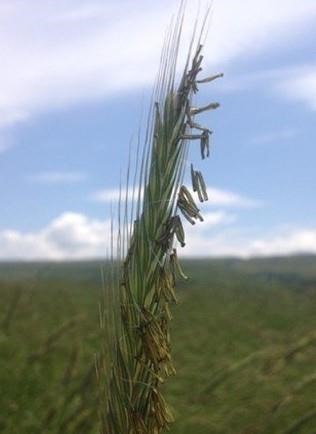Paraquat-based burndown programs can be used as an alternative for termination of winter cereals but may be less consistent across plant growth stages. Tank-mixing paraquat with a triazine herbicide (atrazine, metribuzin) will improve burndown activity for winter cereals and we strongly recommend their inclusion in this scenario. Using a high carrier volume (20 gpa) and flat fan nozzle tips will also be critical for achieving adequate coverage, particularly in thick cover crop stands.
Glufosinate (Liberty) and grass herbicides (Group 1), such as clethodim (Select) or quizalifop (Assure), are unlikely to be effective burndown alternatives to glyphosate for control of winter cereals, particularly when applied during periods of colder temperatures in the spring. In soybean, it will be a better approach to use glyphosate as the pre-plant burndown product for winter cereals and use timely post-emergence applications of a Group 1 herbicide to control small summer annual grass weeds as an alternative to a post-emergence glyphosate pass. Post-emergence corn herbicides that have activity on small summer annual grass weeds, such as nicosulfuron (Accent), rimsulfuron (BasisBlend) and Group 27 products (Impact, Shieldex, Laudis) will not likely control winter cereals that survive pre-plant burndown programs. Consequently, it is important to optimize glyphosate- or paraquat- burndown programs to achieve complete control of winter cereals if glyphosate is in short supply.
Harvesting winter cereals for forage
Chopping winter cereals prior to anthesis is generally not an effective method of termination. For example, previous Penn State field trials have demonstrated that chopping cereal rye at the late-boot stage can result in up to 80% regrowth and chopping at the mid-heading stage can result in up to 50% regrowth. Spraying winter cereals with common burndown products (i.e., glyphosate, paraquat) prior to forage harvest is illegal. Consequently, termination of winter cereals that has been harvested for forage is best managed with post-harvest herbicide applications.
Glyphosate is a more effective burndown option than paraquat for post-harvest termination of winter cereals. It is likely not necessary to delay termination after harvest to allow for regrowth when using glyphosate as long as the harvest height results in enough green leaf tissue at the base of plants to absorb the systemic herbicide and weather conditions (> 55°F) are optimal for uptake and translocation. Cooler temperatures (< 50°F) will slow the activity of glyphosate and may impact termination efficacy of winter cereals following a mowing event. If using paraquat, termination efficacy is likely to increase when application timing is delayed after forage harvest to allow for adequate winter cereal regrowth.
Terminating cereal rye with a roller-crimper
Termination timing needs to be timed to the cereal rye flowering (e.g., anthesis) stage (see Picture 1) to achieve effective control with a roller-crimper. Previous research suggests that approximately 90% control of cereal rye can be achieved when roll-crimping is delayed to this growth stage (Zadoks 68), whereas roll-crimping at early growth stages will provide inadequate control (see Figure 1; Mirsky et al. 2009). The optimal time for roll-crimping is when anthers, which contain a yellow-colored pollen, are visible up and down the seedhead. In most cases, cereal rye stands will vary in growth stage development within fields, which complicates termination timing and can impact overall control efficacy. Most growers who roll-crimp cereal rye do not rely solely on mechanical termination and include a burndown product in their herbicide programs. In our experience, glyphosate-based (0.75 lb ae/ac) burndown programs are equally effective when applied prior to roll-crimping or up to three days after roll-crimping.

Figure 1: Cereal Rye Termination (Mersky 2009)

Source : psu.edu